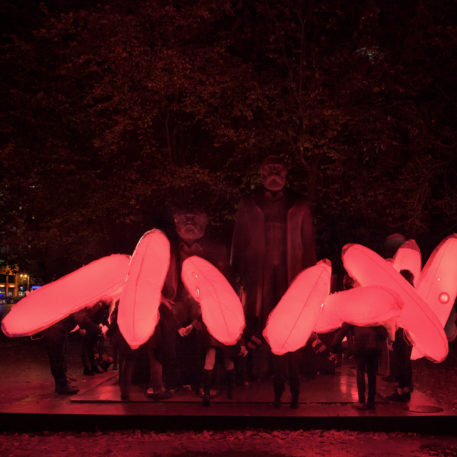“Signals, Resonating Revolutions”: anthropological views on an experimental counter-monument
The participatory art work “Signals, Resonating Revolutions” by Tools for Action, has experimented with new forms of public assembly in the context of the commemorations of the November Revolution 1918/19 in Berlin. This anthropological essay seeks to sketch out and analyse three crucial characteristics of the experiment: its power to unveil the multilayeredness of histories, the making of a counter-monument, the fostering of dissensus.
- by Charlotte Klein
Running, jumping, bouncing, laughing. I laugh. I laugh a lot seeing others wiggling with the inflatable sculptures on their backs. A swirl of red light: when I twirl around with that guy, I imagine how it looks from afar. I cannot turn my head all the way to see the sculpture on my back, to see my red light. But I hold the switch: click, click. And again. Am I on or off, now? Flicking lights in a domino effect, forming a snake, making a circle, running away pretending to be a shooting star, and again twirling. Seeing the group with some distance it looks as if they are doing gymnastics: in a circle holding hands, bending to the right, then to the left. I catch up, squeezing into the circle. We bend to the front and our inflatables touch over our heads – creating a space, a secret space. Faces shine red, and happy. Seeing one another in our secret space.
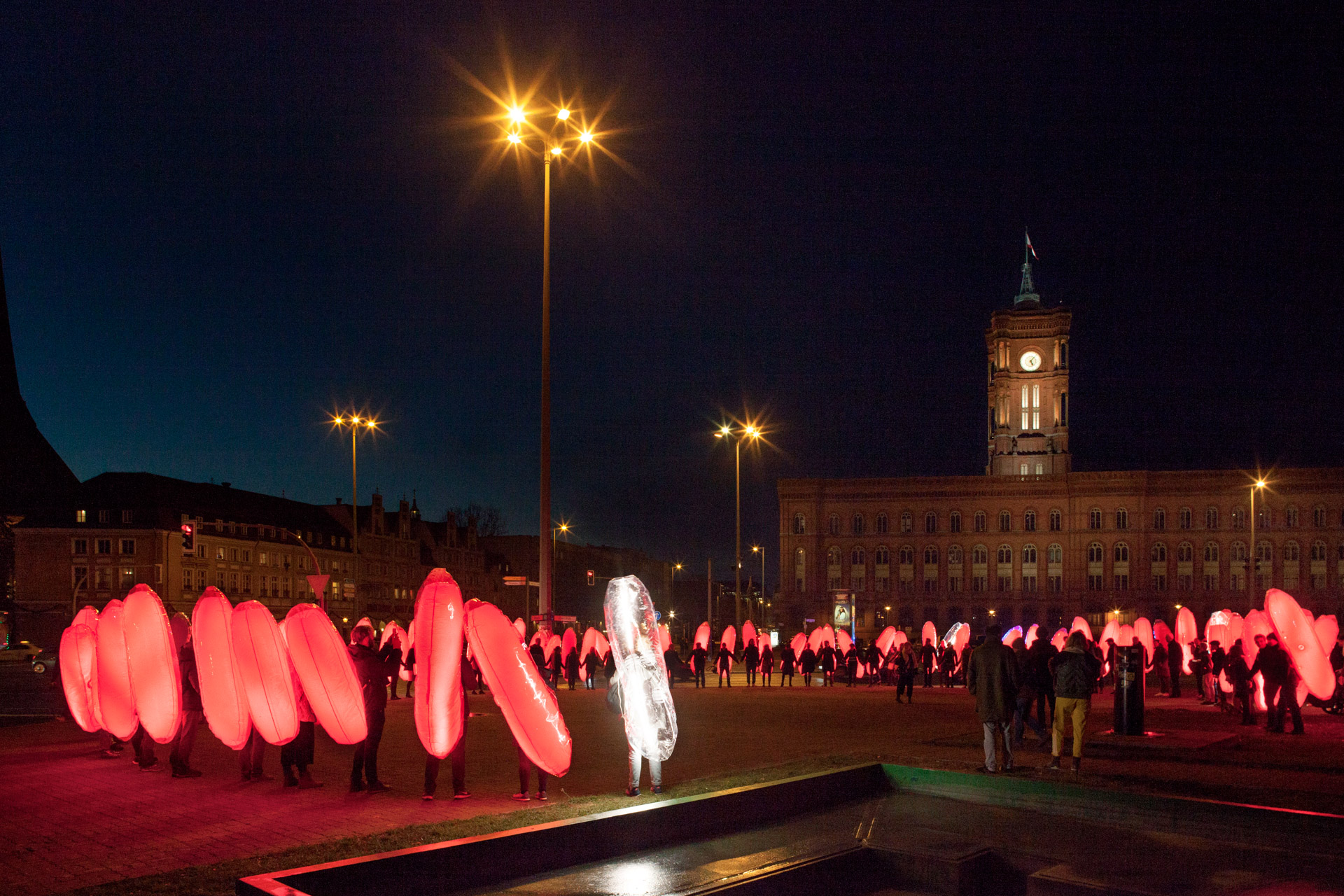
“Signals, Resonating Revolutions” is a participatory and experimental performance by the art and activism collective Tools for Action. They developed and built a hundred red inflatable light sculptures in order “to celebrate the joy of assembling and to test new forms of collective communication in public space”. The experiment was the opening event of the Berlin-wide project “100 Jahre Revolution Berlin 1918/19” - a “commemorative season” celebrating the 100th anniversary of the November Revolution in 1918, which led to the Weimar Republic. The whole project was organised by Kulturprojekte GmbH, a subsidiary company of the state of Berlin, which develops, coordinates and promotes cultural projects in the city. The vignette at the beginning of this piece captures some of my own experiences in the first experiment on the 11th of November 2018 in Berlin-Mitte. In the following, I seek to sketch out three crucial characteristics of the experiment: first, the multilayeredness of histories highlighted by the experiment, secondly, it works as a counter-monument, and finally, it fosters dissensus.
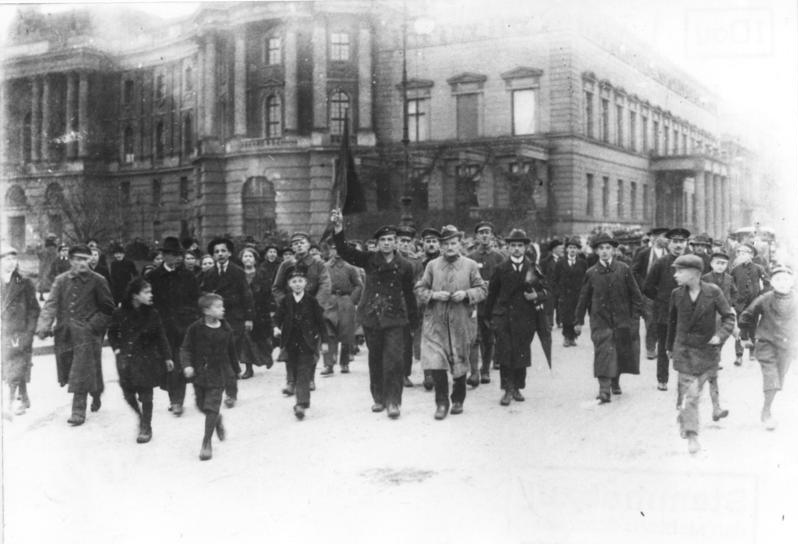
Firstly, “Signals, Resonating Revolutions” facilitates an understanding of the myriad modes of collective memory making, as it allows us to trace the multiplicity of overlapping historical narratives. The date of the November Revolution, the 9th November, is coined by polarising political and ideological moments in context of German historical narratives: the celebration of the revolutionary proclamation of the free democratic republic in 1918 coincides – not by hazard, but out of fascist political strategy (see Tworek and Weber, 2014) – with the commemoration of the pogrom against Jews in Nazi Germany in 1938. Hence, the celebrations of the November Revolution including Tools for Action’s collective experiment needed to take place two days later, on the 11th of November 2018, as the uprisings could not be celebrated on the same day as the killing and persecution of hundreds of Jews was commemorated. The institution in charge, in this case Kulturprojekte GmbH as an arm of the Senate Department of Culture of Berlin, aligned these acts of public commemoration in accordance with what is understood to be common sense and value. Clearly, this case shows, that the negotiation of this multilayeredness is a political act.
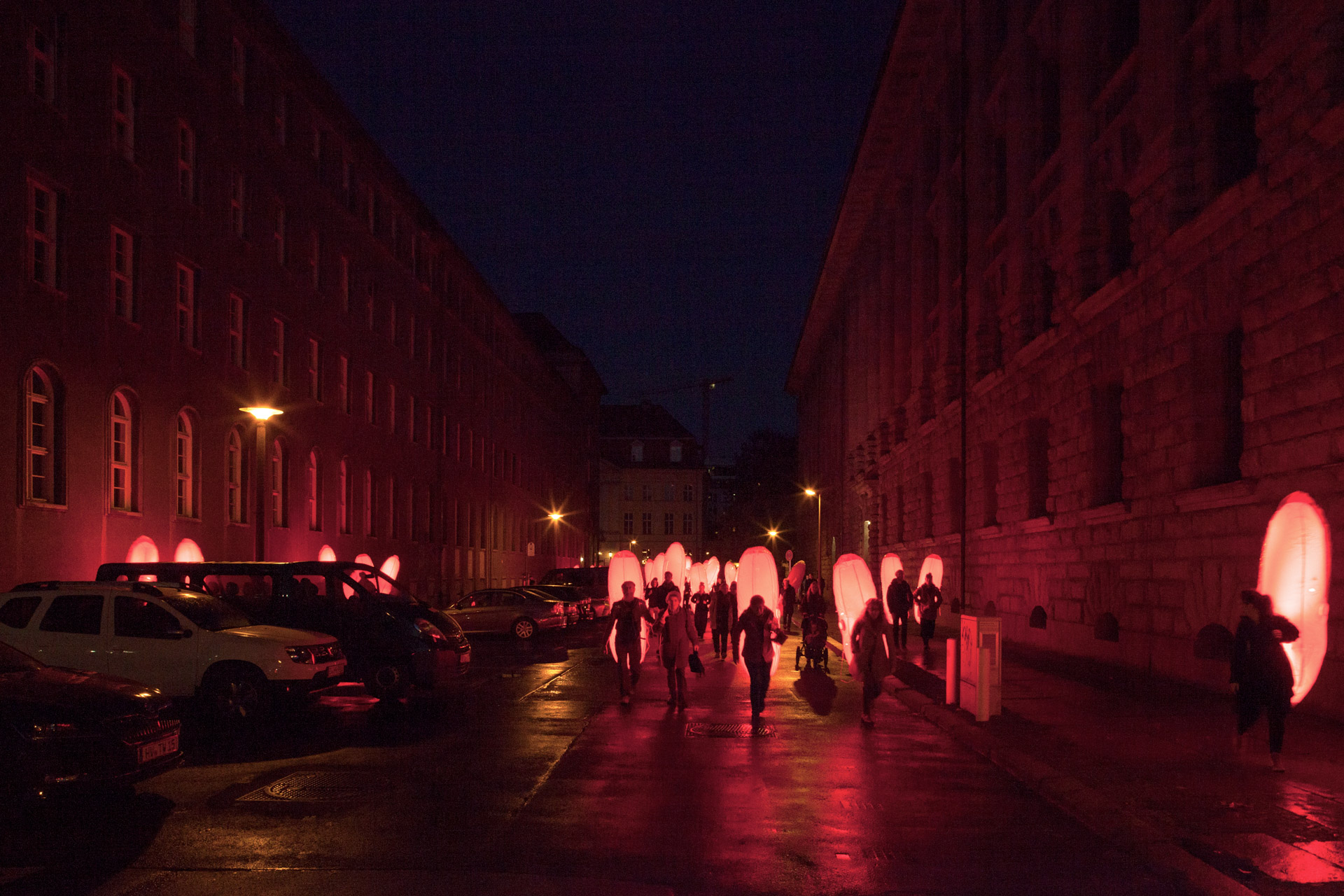
Moreover, by directing the performance along chosen prominent sites of the November Revolution, the shiny, inflatable tools highlight the eclectic relationship between history and urban space. Landscapes, and the urban in particular, are coined by change and reflect a multitude of histories. Working as “the locus of the collective memory” (Rossi in Hebbert, 2005: 587), the urban landscape acts as a reminder of the past, and as background for current actions and imaginations of futures – of utopias. Hence, the experiment is nurtured by the place, powerfully pointing to its ambiguity of history. Shedding light on these histories engrained in the built environment, activates and emphasises the landscape’s function as “medium for and outcome of [human] action and previous histories of action” (Tilley, 1994: 23; emphasis of the original). Tools for Action uses the city as space for gathering, exchange, and debate, as “tool of thought and action” (Lefebvre, 1991: 289).
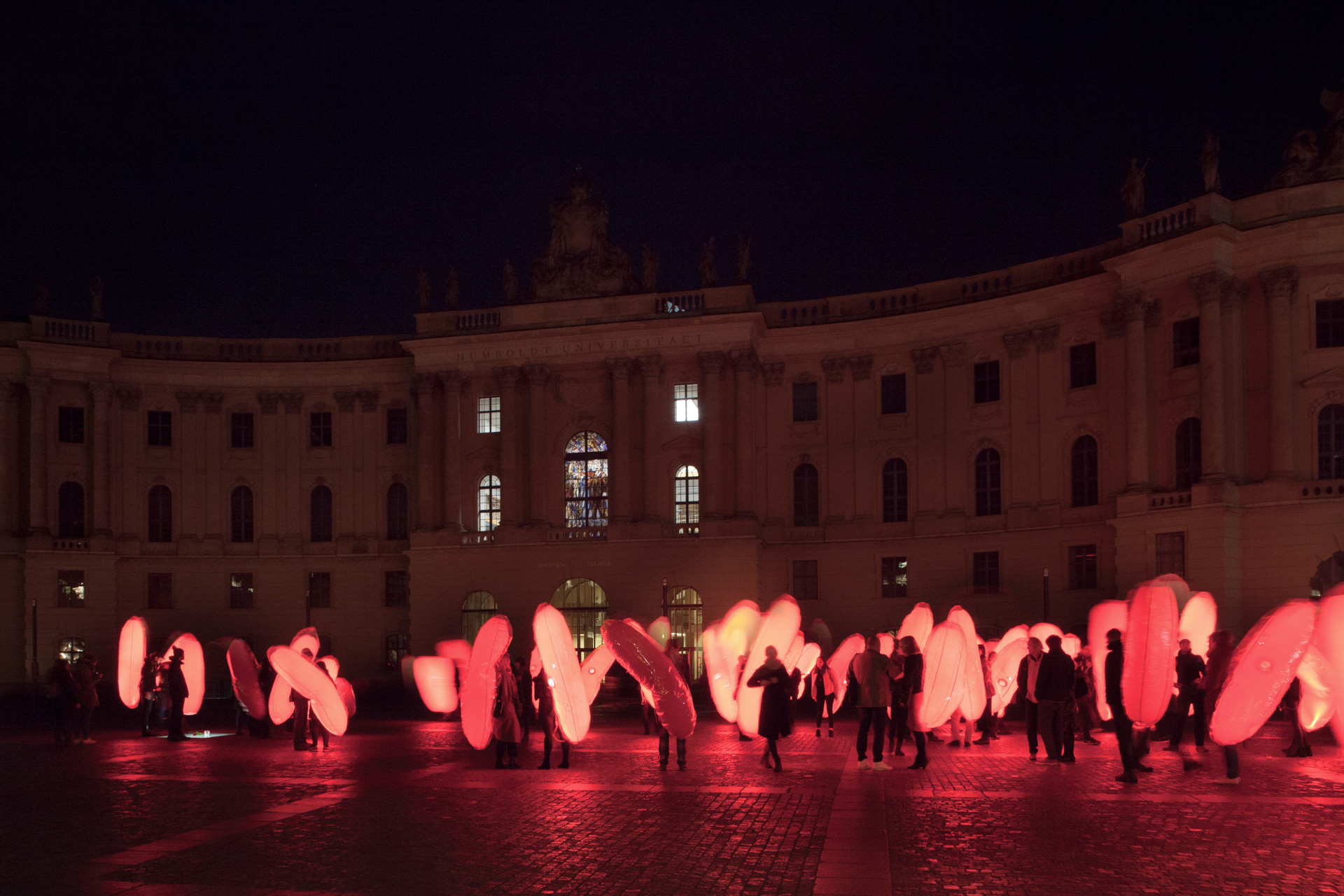
Secondly, the activated inflatables give rise to variations of communication and effect people’s ways of relating with each other. From a subjective perception, or rather feeling, it is not primarily the objects shining and blinking, but the individuals themselves reacting to and resonating with each other. Here, to resonate means to relate, to position and to try to understand one’s own impact on the visual impression of the crowd – the power of the visual is consciously used. The experiment sheds light on people’s role in public space by transferring forms of societal communication and public gathering to a visual level, literally highlighting them. This demonstrates effectively the agency of objects, and artworks in particular, which Alfred Gell (1998) evinces. Being made for playing, bouncing, connecting people and igniting emotions, the inflatables open a “channel for further social relations and influences” (ibid., 2006: 172-173) once they are activated by the participants – who are obviously not only spectators, but exert their agency in synergy with the inflatable on their back. The euphoria captured in the opening vignette also depends on the inflatables’ balloon-like features: their ephemerality is tangible – their fate is literally up in the air. This possible, imposed ephemerality adds up to the whole temporary and performative character of the experiment.
Hence, I argue, that “Signals, Resonating Revolutions” creates an ephemeral counter-monument – powerfully claiming new ways of remembrance. In line with James E. Young’s (1992) argument, that all durable and solid monuments carry “fascist tendencies” (ibid.: 274), Tools for Action playfully challenge permanent perceptions of memory making. I consider the notion of the counter-monument to be fruitful in this context, because it “asks us to recognize that time and memory are interdependent, in dialectical flux” (ibid.: 294). Consequently, the artwork points to the efficacious nature of acts in the present: societal communication, civic participation and public gathering are enacted in the now and have an impact on (imaginations of) futures. The experiment and the inflatables themselves create a queer way of countering memory making, actively working against a reduction of individuals to “passive spectators” (ibid.: 274). Above all, the experiment and its inflatables widen communication channels and heighten the subjective and emotional qualities of memory work.
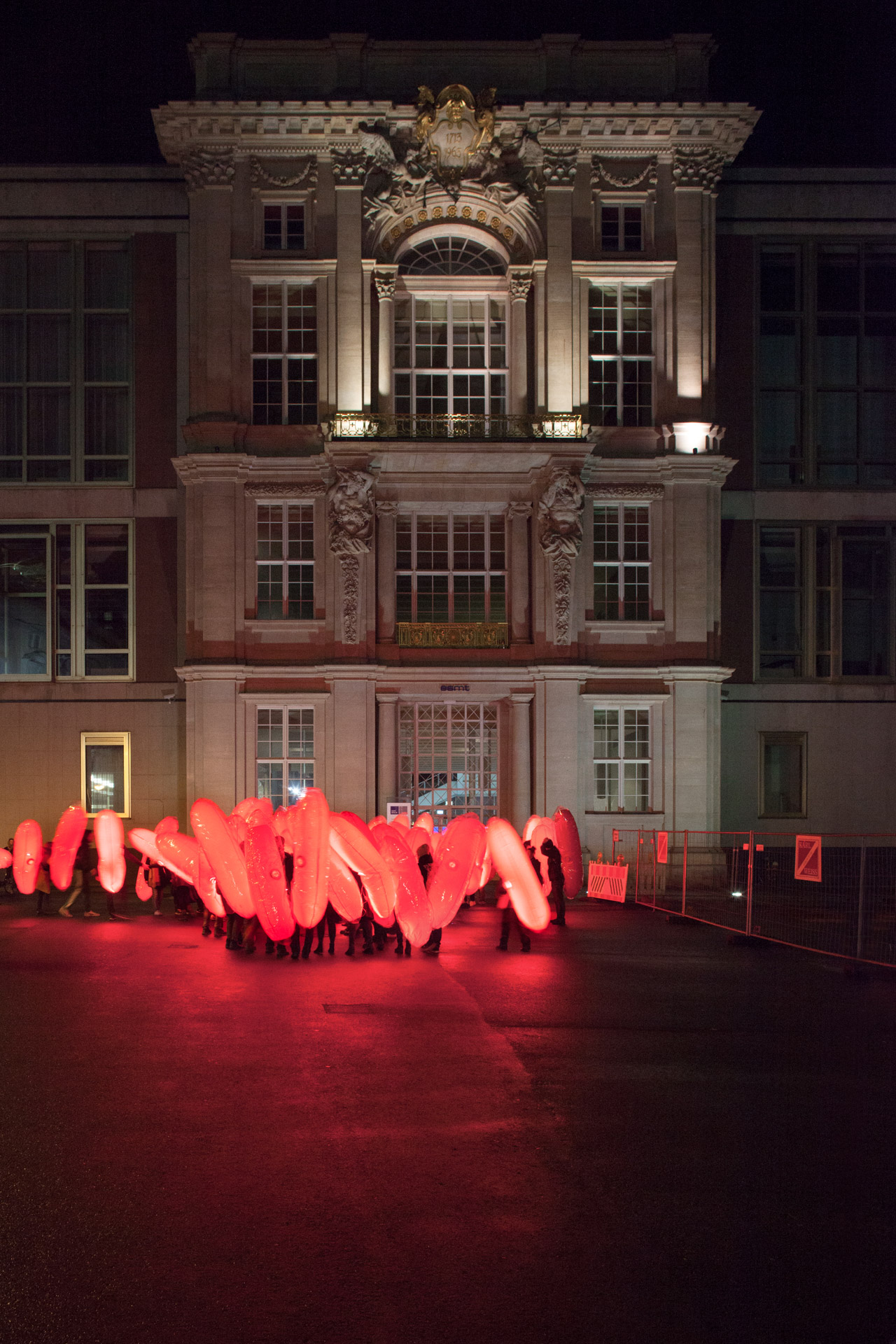
Thirdly, the experiment ignites euphoric and unpredictable group movements in public space. Hence, “Signals, Resonating Revolutions” renders societal possibilities visible and works as “process for social transformation” (Bell in Schacter, 2014: 186-187). Reflexive in nature, the carnivalesque appearance and experience pushes boundaries, underpinned by a stark “belief in the transgressive utilization of public space” (Schacter, 2014: 180). These counter-practices are innovative and productive of meaning. Simultaneously, Tools for Action are funded by and depend on state institutions. In broader terms, I understand the relationship between Tools for Action and Kulturprojekte GmbH as a clash between the notion of experiment – being playful and open-ended – on the one hand, and the notion of event management – being regulatory and output-driven – on the other.
Hence, the experiment and Tools for Action engages in what Chantal Mouffe (2007) calls “the ‘agonistic’ struggle” (ibid.: 3), deemed fundamental to democracy. I understand the experiment as “critical art”, because it “foments dissensus, that makes visible what the dominant consensus tends to obscure and obliterate” (ibid.) The experiment’s agonistic and dynamic ways of moving and assembling in public space aim at a variety of narratives and voices, at discourse and dissensus. Thereby, a way of questioning singularised – supposedly uniting – historical narratives is enacted in public space. Above all, the carnivalesque experiment reveals that behaviour in public space, commemoration and writing of history – all seems to be common sense – are based on hegemonic structures. Thus, any order or narrative is necessarily political. The flicking, bouncing inflatables are tools, which facilitate and enrich public assembly as well as explorations of what dissensus means. The experiment is efficacious, because public space is a “battleground” (ibid.) of narratives and practices. “Signals, Resonating Revolutions” has a reflexive, overturning, and unsettling attitude, producing “new knowledge” (Kapferer in Schacter, 2014: 170) in a civil, emotional, bodily and synaesthetic manner.
Above all, through light and movement “Signals, Resonating Revolutions” lets social relations within the present-day city and its historical entanglements become tangible. Tools for Action’s social experiment reveals the political character of public space and memory work. The inflatables are tools for counter-practices; they challenge not only conventional movement patterns, but also generate knowledge and innovative practices of remembering as well as public assembly. The experiment makes us curious about the utopian ideas and civil dynamics developing at future activations of the tools, when the revolutions resonate again.
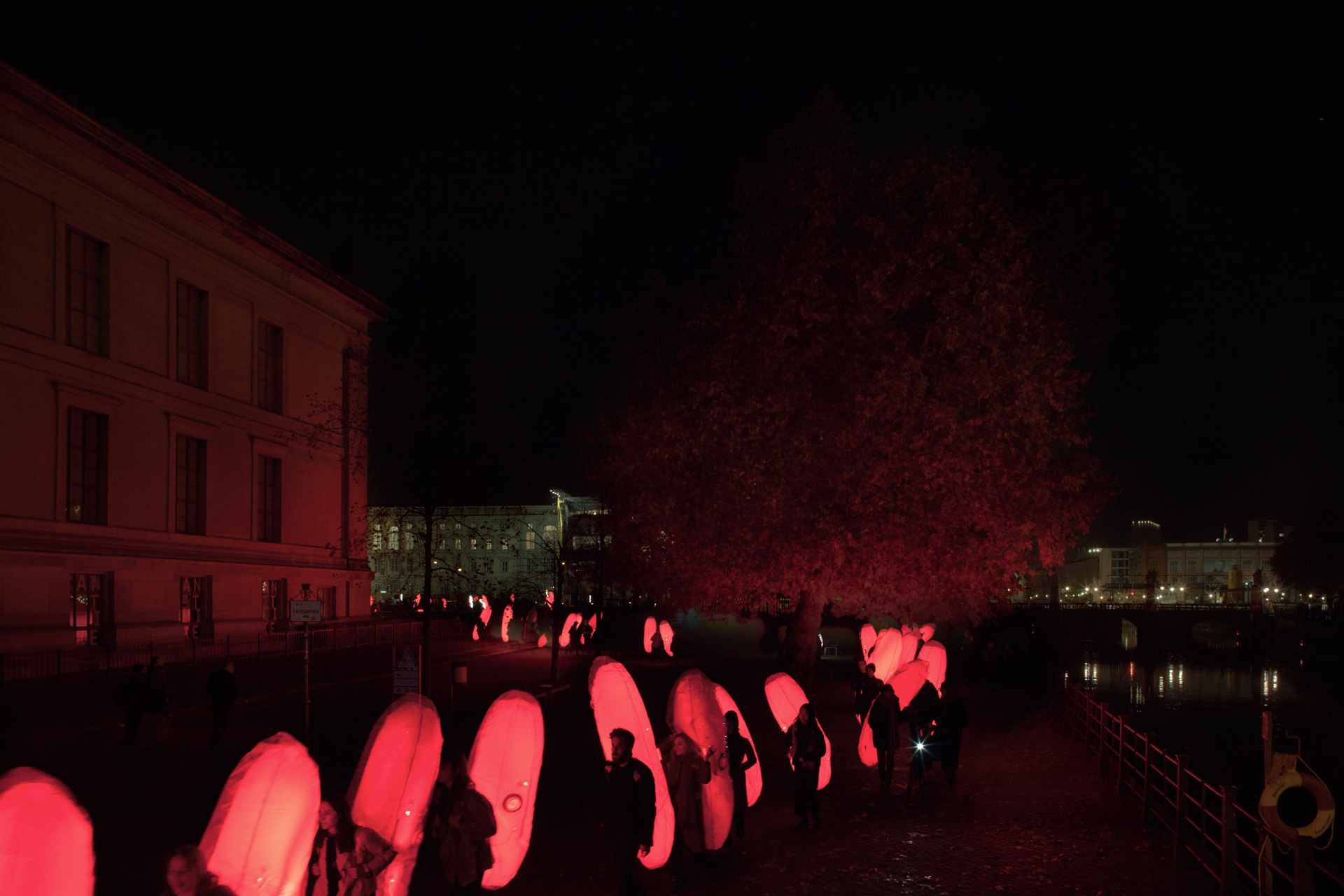
N.B. This sketch is based on a thorough analysis of the experiment; see my essay “Signals, Resonating Revolutions”: Unveiling the power of inflatables in public space and memory work (forthcoming).
by Charlotte Klein | 2019 | [email protected]
University College London Anthropology
Bibliography:
Gell A. (1998) Art and agency: an anthropological theory, Oxford: Clarendon Press.
Gell A. (2006) The technology of enchantment and the enchantment of technology. In: Gell A and Hirsch E (eds) The art of anthropology: essays and diagrams. Oxford: Berg, 159-186.
Hebbert M. (2005) The street as locus of collective memory. Environment and Planning D: Society and Space 23: 581-596.
Lefebvre H. (1991) The production of space In: Jen Jack Gieseking WM, Cindi Katz, Setha Low, Susan Saegert (2014) (ed) The people, place, and space reader. New York, London: Routledge.
Mouffe C. (2007) Artistic Activism and Agonistic Spaces. Art and Research 1.
Schacter R. (2014) Ornament and order: graffiti, street art and the parergon, Farnham, Surrey, England: Ashgate Publishing Limited.
Tilley CY. (1994) Space, place, landscape and perception: phenomenological perspectives. In: Tilley CY (ed) A phenomenology of landscape: places, paths, and monuments. Oxford: Berg, 7-34.
Tworek H and Weber T. (2014) Das Märchen vom Schicksalstag. Frankfurter Allgemeine Zeitung.
Young JE. (1992) The Counter-Monument: Memory against Itself in Germany Today. Critical Inquiry 18: 267-296.
